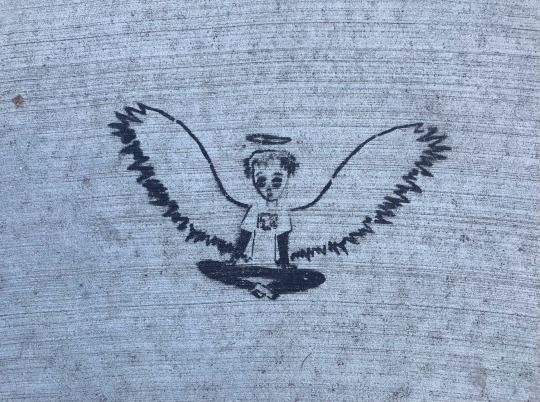Text
Say the Word... (a brain hiccup for art historians)
So I come home from a quick trip to a new, cute, neighborhood coffee shop. Maybe it's the caffeine that is prompting my reflective mood, maybe not, but I find myself critically scrutinzing the shop. I begin a mental list.
Signage: self conscious yet sincere retro-Pop (cute! heartfelt! ironic!)
Pastry display "case": actually, no--it's a piece of custom-made furniture that references an old cathode-ray TV--only overgrown, larger. Dec arts types would quickly spot the conical, tapered legs on which barely balances the bulk of a wooden rectangle, its center cut out in a giant, transparent oval. Its implied message?: "Where once you watched shows, now we watch starch!" or, "Pastry is our narrative." Though I doubt that any of the young folks who patronize the place even catch a whif of that memory/nostalgia.
THEN: My brain hiccup: Suddenly, as I strive to remember my dec arts vocabulary (above), I get the word "entablature." It is totally the wrong word. It's an art history 105 ancient architecture word. Yet, I must say it.
"entablature"
I speak it to an empty room, for no apparent reason. And as soon as I do I feel my mental state relax around its sound as it exits my lips.
Aaaaah.
Why did I have to say "entablature"? Why so compelled?
Was it because my son and I had been discussing Kafka earlier? And George Perec?
No. That's coincidence.
As I mention before: It may have been the caffeine (winding down) that prompted this mis-firing in my vocabulary; or maybe (I began to reason) this is just the nature of received knowledge. Sometimes all the stuff you learned in art school just needs to off-gass--the "knowledge" that somebody else told you; maybe you have to twist the freshman art-history-class nozzle in your brain and let some Greek temple component out.
Clearly my pressure has been building up. As a longtime teacher, I can say that as a new semester is about to start (a new school year -- Egad! MFA majors await me!) I'm feeling the strain. I used to think I knew why I know the things I know. Now, I just say them.
Wait: is that teaching?
Am I just passing down more of that academically received discursive knowledge for the next generation of hiccups?
I can't have any more coffee to feel better. I will have to just ride this one out and work on my syllabus.
Next week, folks. But WAIT, let me quickly search...Aha! Why must I psychologize myself? find flaws, "reasons"?
This, on Women's Knowledge, fits the bill.
It seems that women process knowledge differently, in no small part based on their trust -- or rather well-deserved mis-trust -- of sources: male, academic, or otherwise.
Yes, kids, next week. You'll be getting a doozy of a first class.
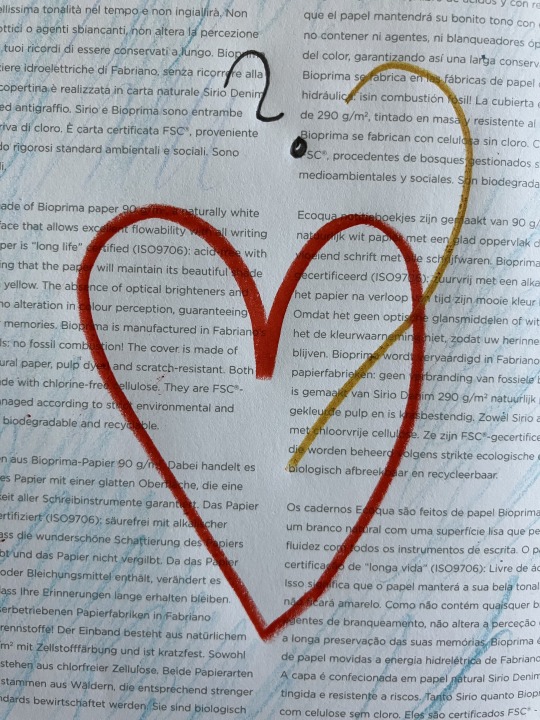

#coffee shops in Brooklyn#caffeine#received knowledge#women's knowledge#academia#discursive knowledge#gendered knowing
3 notes
·
View notes
Text
Lanier doesn’t even like the term artificial intelligence, objecting to the idea that it is actually intelligent, and that we could be in competition with it. “This idea of surpassing human ability is silly because it’s made of human abilities.” He says comparing ourselves with AI is the equivalent of comparing ourselves with a car. “It’s like saying a car can go faster than a human runner. Of course it can, and yet we don’t say that the car has become a better runner.” -from an article in The Guardian 03/23/2023.
7 notes
·
View notes
Text
Tube-splanations tire me

My good friend (smart guy, currently getting his PhD) gets into a deep conversation with me on the phone. While we’re talking, I immediately visit my CUNY Library website on my computer, enter my credentials, and find three decent, peer-reviewed articles on the topics we are discussing (systemic racism, religion...too much to summarize here; suffice it to say, deep, and deeply nuanced, stuff!). I shoot him links to PDF’s of my resources in a text, so we can talk some more, and apologize for not spending more time on them at the moment.
He says “Thanks!” and sends me back:
A YouTube video.
Wow: A celebrity will help me understand things! (Kevin Hart is pictured on the thumbnail and in the title), and Gee! It’s 10 minutes long, so I can watch it right now. And look at all the easy-to-read yellow hyper captions so I be sure to know what points the video is making. Not to mention that now, my YouTube algorithm will be tweaked for more of the same.
Then he texts [referring to the video], “I really want to know what you think.”
[pause; 4 days later...]
I still haven’t texted him back, because, just as I tell my students to exercise “click restraint” when getting the results of a search on Google, I also think there is such a thing as “text restraint.”
I want to say: “Please stop Tube-splaining things to me.” Or “I am not receptive to visually stimulating Tubesplanation today.”
Or maybe I want to say: “Hey, I’ve gotten so many videos lately, that this week I just need to have my YouTubes Tied.”
I made up the above terms. I have not spoken them, though. I only use them in writing. I have zero idea how to talk to my very smart friends about their penchant for Insta- and YouTube-link slinging in my direction.
6 notes
·
View notes
Text
books over the horizon
Respectable! a Tower of Babel built with books found in Brooklyn, that dwarfs a city...Lothar Osterburg, artist.
https://en.wikipedia.org/wiki/File:Lothar_Osterburg_The_Tower_of_Babel_2015.jpg#/media/File:Lothar_Osterburg_The_Tower_of_Babel_2015.jpg
0 notes
Text

This is art and also collaborative fun.
0 notes
Photo



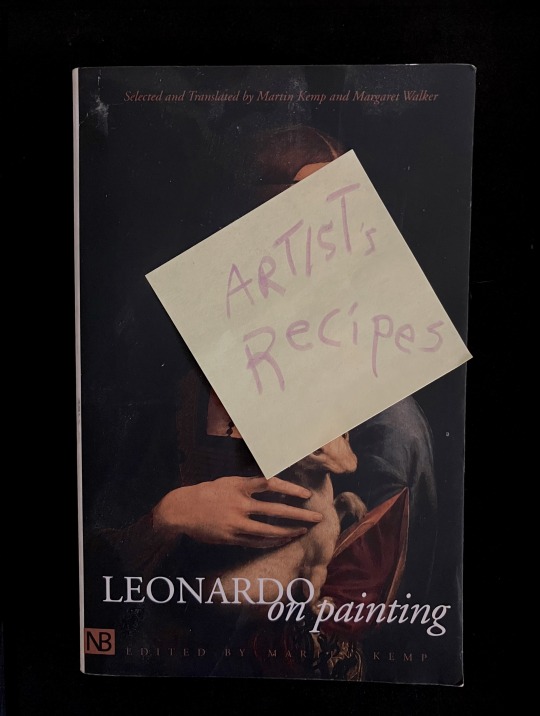

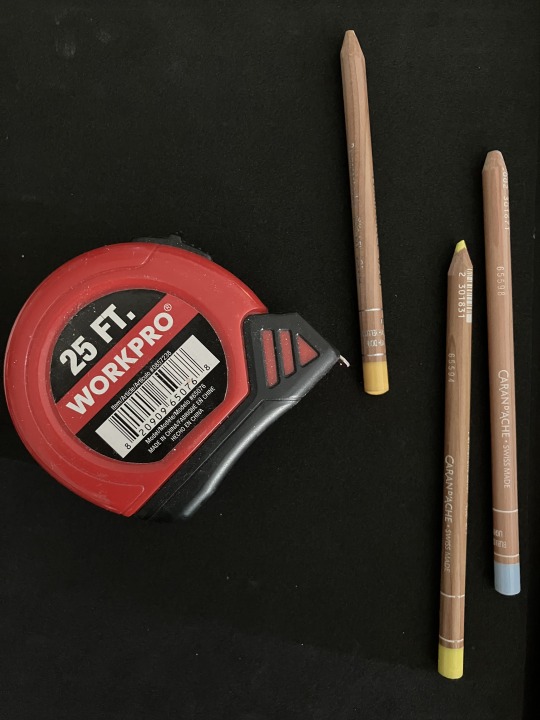
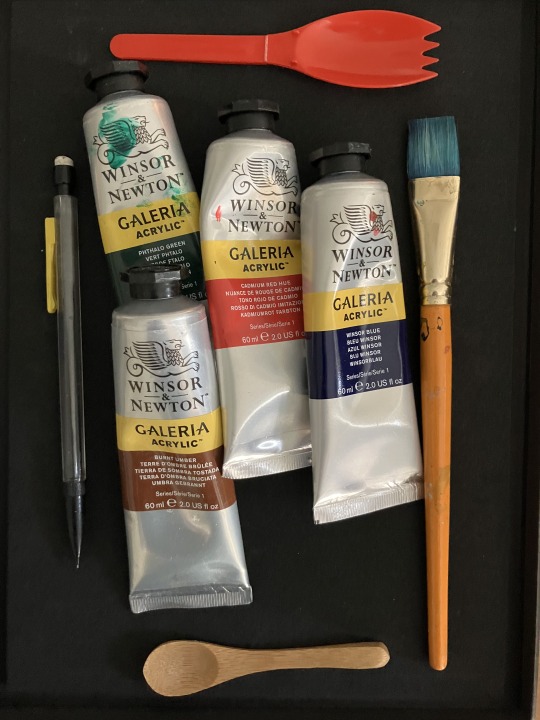
The Artists’ Recipe Book ™️ is coming to a Library/Kitchen near you.
3 notes
·
View notes
Text
My grandmother, Celia, O”H, the cat lady of Borough Park.
It would have been my Bubbie’s birthday today. Among her many talents, she was the unofficial/official feeder of all the stray cats of Borough Park (well, all the ones that I could see, whenever I visited her.) She would go for her walks around the neighborhood, and leave food. She’d make this kissy/clucky sound with her lips pursed when she passed certain corners, and boom, cats would come running outta nowhere.
They knew her.
It was a regular thing, and she took it seriously, and truly cared about them. One time I asked her why she had to go at such odd times, and she said it was so that she wouldn’t get caught.

I asked my friend for a couple photos of her lovely cats, Siri, above^^
and Elroy, below:

and get this: it didn’t even occur to me until I got the photos, that my friend’s name is also “Celia.” And she, too, is a good friend to cats.
It wouldn’t be Bubbie’s day if I didn’t include a feral cat, so here is one that, according to an article I just read, lives in Disney Land:

0 notes
Text
Dim In Ish Ed == My Editorial on Dance and Disabilities and Dec 3
Dim In Ish Ed
Or
How I Will Spend My Disability Holiday
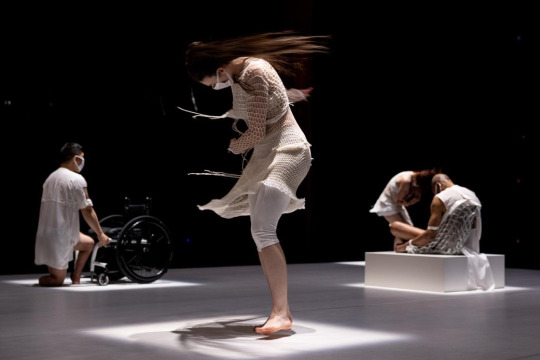
^Excerpt from “In Flight,” performed by Heidi Latsky Dance in Washington, DC last September
I’d like to think that I have a grip on my life, but sometimes that grip weakens. Strength—perhaps not physical, but emotional and mental—has usually been my best quality.
So what do I do in moments of weakness? Shoulder on…face the music…or, maybe, just maybe this year, I ought to pay attention to a holiday I never heard of before:
December 3 – International Day of Persons With Disabilities.
Now, even if you (Reader) have the faculties we ascribe as “normal” – aka, you can walk without assistance; you can order a latte and be understood; you are sighted enough to drive a car; you can hear those announcements on the subway (well, who can?) – I suggest you celebrate IDPWD this year, too.
Celebrate the fact that, for starters, You Are Not All That. No one is. Maybe you’ve let a lot of other people who struggle with disability fly under your radar; well, celebrate the fact that you just took a moment to re-think that. Because, until we can celebrate difference, we won’t truly value it.
Let me pivot for a moment into statistics. As of 2020, the WHO (World Health Organization) reported that a whopping 1 billion of the world’s population are suffering from some sort of disability. 253 million people are affected by some form of blindness and visual impairment; 466 million people have a disabling deafness and hearing loss; 75 million people need a wheelchair on a daily basis; and, depending on whose reports you consult, anywhere from 93 million to 240 million of those persons with disabilities are children—almost 2 million of them living right here in the US. (footnotes below)
The Americans with Disabilities Act formally passed in 1990, and most likely, its fruits have been in your face: ramps required at civic buildings; elevators that ‘ding’ at floors for the blind; room numbers underscored with braille in hotels and office buildings, and of course, those pipe handholds in restroom stalls that accommodate wheelchair users. (Face it, you use those larger stalls, too!)
The fact of the matter is that as much as we have visibly done, we have more to do. (I haven’t even mentioned aging, and a host of what are called “invisible disabilities.”) Too many people in the world are functioning well below their capacity. Simply put: You don’t know what it’s like to live with a functional disability. Day. To. Day.
Take my brother, Joel, who was a paraplegic for the last 30 years of his life. His room at the Liberty Lodge in Williamsport, PA where he lived for a number of years was wheelchair enabled, and the staff were supportive of his needs beyond belief. Thing is, the architectural design (an old style, three-floor motel) was not up to snuff. Yes, the bathroom was “wheelchair accessible”—large enough to accommodate his motorized scooter, with a handrail and a roll-in shower—but in order to actually get in to the bathroom, the entire door had to be taken off its hinges and removed. Hence: accessibility but zero privacy.
And of course, there’s the lab at Penn State University, where Joel was studying to get his Masters in of all things Disability Studies. He liked to take photos of it in winter, because its one, puny ice-and-snow covered ramp made it impossible for him to get to class. (Penn State’s motto is “We Are,” but I’d like to add the word “Clueless.”) And don’t get me started on the cute vegan bakery-coffee shop across the street from where Joel lived. There were three steps to get in. And Joel liked his coffee. The management had a point, namely, that the building was historically zoned and couldn’t be altered architecturally. Plus, there was a Panera Bread in the next block with a ramp, but Joel wouldn’t hear of it. He threw himself over the doorway’s threshold one day, crawled on his elbows to a chair, and hauled himself up on his “sticks” (those metal crutches with rubberized ends) and demanded to be served. (All the while being videotaped by his health care attendant, of course.) Well, this poor small-business owner eventually had to shell out her own money to buy a ramp. No one else would buy it. So that’s victory, one guesses. But now they are out of business, and another coffee shop is there. Time to start all over.
The day to day is hard, you admit. But the day to be aware is now.
What can we do – and perhaps, more importantly, why, should we – this December 3rd?
Joel died on May 3, as much from depression and mental illness as from the fact that his body just couldn’t keep up with the strain of his disabilities. I can only tell you bits and pieces of his final months. Frustrated, and probably off his depression meds, Joel sprayed graffiti on the wall of the building where he lived. (I can show you a picture if you like – it’s actually more of a Kabbalistically inspired artwork, really. Nothing dirty or harsh.) He got kicked out. He then went to the doctor, and got mad that the office didn’t have a power door. So he went and got a hammer and hit it. The door was glass and shattered. The police were called. He was handcuffed and sent to jail. He got Covid in jail, and didn’t get adequate treatment. He went to a facility. Then a hospital. Then hospice.
Protest wasn’t working for him, to say the least. It wasn’t the 60s anymore, dear Brother. No one was really listening.
This weekend, I am going to participate in something more “artsy” than Joel might have conceived, given his devotion to social and political reform, though I hope he would approve.
At 58 years old, I could say I’ve “always danced,” but it’s only in the last few years it’s become a defining medium in my life. I’ve cyphered in local “sessions” of free-style dance held at night at Brooklyn Ballet. I’ve done “ecstatic dances” Online throughout the Pandemic. I also participated in Dance Parade this year, and that’s when I met Heidi Latsky Dance’s administrator, Jamie Dresser. I told her that I’m not as young as I used to be; that my body is, to say the least, quite limited at this point.
She said Latsky doesn’t see things like that.
Every year, on December 3rd, Heidi Latsky Dance hosts “ON DISPLAY,” a performance-meets-art installation that involves dancers of all stripe. (Latsky’s company is known for including both dis-abled and able-bodied dancers in their troupe. One of them, Jerron Herman, a wonderful young dancer who lives with Cerebral Palsy, has been getting some worthy attention of late.) Now, I’m lucky enough to say that I’ve been invited to participate with them.
In ON DISPLAY, dancer-participants actually hold still for most of the piece’s duration. If and when they move, it is slowly, incrementally. During a training session earlier this week, Latsky told us that as dancers, we ought to concentrate on “discovering new positions, not arriving at new positions” as we inhabit the public space. That we would be going inside, eyes closed, a lot of the time, and trusting (e.g., not worrying about) how we looked.
Meanwhile, viewers on Dec 3rd will be free to roam around us as they wish and observe us --much like they might sculptures in a typical sculpture court: objectifying us, thinking about what they see. They could potentially get very close to us, so we ought to be prepared to feel vulnerable, exposed. It would be up to us as dancers, Latsky told us, to find meaning in the stillness. Some of the dancers will be blind; some in wheelchairs; some missing limbs; some able bodies.
And at least one missing a brother.
Dec 3 will be my first foray into public performance in a long time, one where, quite literally, I will be doing my best to hold still. Latsky sees this initiative as much as a moving meditation for each of the performers as a piece of aesthetic dance/performance. And I will be striving to come to terms with a world without Joel, and a world that is not whole until I can find a place in it without him. Yes, I do have all my abilities and senses, for which I am truly grateful, but I have been left bereft by his loss exactly seven months ago. Diminished by this lack, I am too often consumed by how little I can do, and did do, to ease his pain and I often feel quite helpless in the face of the injustices that consumed him.
So, before Dec 3, exactly seven months from his passing when I will turn into a “sculpture,” I wanted to take a moment and write down what, if any, inspiring thoughts I might have; what is my perspective as a sister/dance who is “able” but also somewhat disabled by age and grief and also respectful of Limitation.
What I came up with so far:
We need to expand ourselves beyond our own Limits on a fairly regular basis.
We have to go to a place of dis-comfort in order to change, and also to feel empathy for others who face struggles and, that way, we can probably help people because we are genuinely dancing our dance.
As the day approaches, I am frankly feeling far more scared than I first thought. I didn’t realize when I signed on for ON DISPLAY (a pretty immersive experience) that I won’t be able to answer “how it all went” until much, much later; that I am probably opening a door to a new awareness, and that, once I do, I won’t be able to close it again; that I will have to be in the Moment (in this case, an hour and a half) even if that Moment is difficult, no matter how I feel. No matter how I look to other people. What am I proving to myself? That I grieve? I am guessing that the grief won’t go away. Perhaps some of my frustration might. Perhaps.
“We do what we can.” That’s the adage that comes to my mind. But I will leave you with the motto Joel always used to say to me, which happens to be international disability community’s:
“Nothing about us, without us.”
Sarah Schmerler is a writer, artist, and educator who lives in Brooklyn. She performed in person at NYU’s Tisch Sculpture Court on Dec 2 at 12PM in a work called ON DISPLAY by Heidi Latsky Dance, and will be participating on the Online initiative, ON DISPLAY GLOBAL, on Zoom Dec 3 from 7-8:00PM.
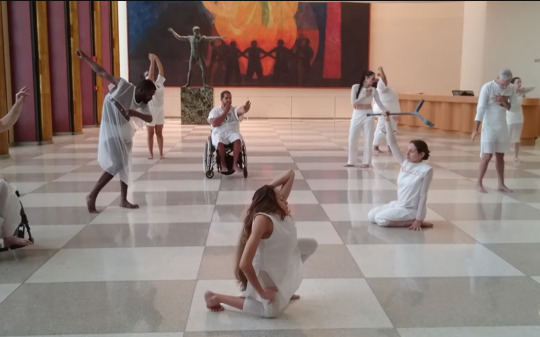
^Still scene from a video of ON DISPLAY performed by Heidi Latsky Dance at the United Nations, Sept 2015
1According to the CDC, right here in New York State, 21% of adults struggle with some form of disability. 2Other statistics according to inclusivecitymaker.com, a website run by French company Okeenea, manufacturers of audio beacons and other accessibility devices employed in cities like Paris and New York. https://www.inclusivecitymaker.com/disabled-people-in-the-world-in-2021-facts-and-figures/
#International day of persons with disabilities#disabilities#contemporary dance#dance activism#ondisplayglobal
0 notes
Video
youtube
Warburg Library’s way of serendipitous discovery; Die Guten Nachbarn
3 notes
·
View notes
Text
Shelf Discovery (Aby Warburg style)
https://youtube.com/clip/UgkxRdIut_wWwuhtzyJSOMAn5eW5gUAexnkU
(this is the link to the full video of the next post’s clip)
0 notes
Text
Yoko “Yes Poem”

A page from my reporter’s notebook (framed), written in by Yoko Ono.
“Yes Poem”
Yoko Ono
pencil on paper
2000
0 notes
Text
This guy; at the Whitney Biennial; worthy and compelling.


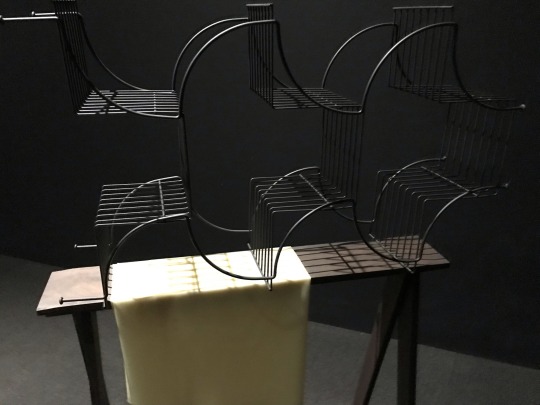
0 notes
Text
“Twired”
adj. when you’re tired and wired at the same time.
1 note
·
View note
Text
reading Balzac
reading Balzac is like reading a magazine article written by G-d.
0 notes
